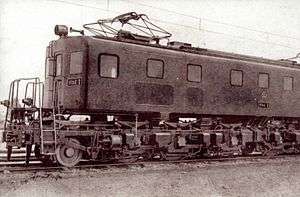DeRoI-class locomotive (Toshiba)
|
Builder's photo of DeRoI-1 | |||||||||||||||||||||||||||||||
| |||||||||||||||||||||||||||||||
| |||||||||||||||||||||||||||||||
| |||||||||||||||||||||||||||||||
| |||||||||||||||||||||||||||||||
The Toshiba DeRoI-class (Japanese: デロイ) was a group of nine boxcab-style electric locomotives with regenerative braking (type EL14AR[1]) and the capability for multiple-unit control manufactured by built by Toshiba in 1943-44.[2] They were very similar to the Mitsubishi-built DeRoI-class locomotives and the DeRoNi-class locomotives built by Hitachi. They were built for the Chosen Government Railway (Sentetsu), and after the partition of Korea were inherited by the North Korean State Railway, where they were known as the Chŏngiha (Korean: 전기하, "Electric 1") class.
Description
Sentetsu had issued its requirement for an electric locomotive in 1938, beginning discussions with Mitsubishi in that year regarding the development of a plan to electrify certain rail lines in Korea. Part of the Railway Bureau's goal with the electrification plan was to set a new world speed record, and to go with that, a state-of-the-art locomotive was desired. The project entailed many Japanese firsts, including the first use of 3,000 V electrification, and, specific to the DeRoI class locomotive, the first use of regenerative brakes.[3] The resulting design was very similar to the EF12 class of the Japanese National Railways.
When the electrification of rail lines in Korea was begun in 1943, Sentetsu ordered twenty DeRoI class locomotives of 135 tons - sixteen from Toshiba[4] and four from Mitsubishi[3] The original class name, デロイ (DeRoI), comes from the Sentetsu classification system for electric locomotives: DeRoI = De, for "electric" (from 電気, denki), Ro, to indicate six powered axles (from Japanese roku, 6), and I (from Japanese ichi, 1), indicating the first class of electric locomotive with six powered axles.[5]
Though generally quite similar in appearance to the Hitachi-built DeRoNi class and the Mitsubishi-built versions of the DeRoI class, there were a number of features that distinguished the Toshiba-built DeRoI class from the others. These were: unequal spacing of side windows; a distinctive ventilator shape; and a distinctive arrangement of the deck railings.[6]
Although the major design work of the type was undertaken by Mitsubishi, the first DeRoI-type locomotives delivered to Sentetsu were those built by Toshiba. The sixteen units ordered from Toshiba were intended for use on the Kyŏngwŏn Line; however, only five had been delivered by the end of the Pacific War - numbers 1 through 3 were built in 1943 (June, August and December respectively), numbers 4 and 5 in 1944 (January and October.[7]
At the time of the partition of Korea after the end of the Pacific War, of the five Toshiba-built DeRoI class locomotives, four were in the North and one was in the South, in Seoul for repairs.[4] After the partition, the Allied General Headquarters (GHQ) in Tokyo ordered the delivery of three Mitsubishi-built and seven Toshiba-built DeRoI class locomotives to Korea as reparations; these were all delivered to the South.[8] DeRoI 6 had been completed in November 1944 and taken to the port at Kobe, Japan, for delivery, but was subsequently returned to the factory; this became the first of the ten new locomotives to be delivered to Korea, in March 1946. Numbers 7 through 9 were built and delivered in 1947 (January, June and September respectively), while the last three, numbers 10 through 12, were completed in 1949; however, after the outbreak of the Korean War and the destruction of the (incomplete) electrification in the south, these three units were scrapped in Japan, never having been delivered.[7] Of the locomotives delivered after the partition, all but one were eventually captured by the North Korean army and taken to the North; the eighth unit had been in storage at Pusan, and was scrapped in 1958 without ever having been used. Thus of the 16 units actually built, 15 ended up in the North.[4]

Plans were made for Toshiba to build some DeRoI class locomotives for the Soviet Union as war reparations, but due to the escalation of the Cold War after 1949, these were never built.[7]
As the Korean War caused the destruction of the electrification of North Korea's rail lines, they sat disused until 1956. In that year they were reclassified Chŏngiha (전기하) class and numbered 전기하1 through 전기하9, and were refurbished at the engine shops at Yangdŏk for use on the Yangdŏk-Ch'ŏnsŏng section of the P'yŏngra Line, which had been electrified in 1956 as the first stage of North Korea's electrification plans.[9]
Originally painted brown, they were repainted in 1958-59 in the light blue over dark green livery to match the scheme that was made standard with the introduction of the Red Flag 1 class electric locomotives.[5] At some point, the original pantographs were replaced with pantographs of the type used on the Red Flag 1 class locomotives.[10]
As of 2011 at least one, Chŏngiha 3, is still operational, based at Kowŏn.[10] This unit was inspected by Kim Il-sung[10] and, as such, it is kept in a pristine state as a "historic monument of the Revolution".
References
- ↑ "デロイを探せ!(その50) ソ連向けデロイの輸出許可申請書(その1)". ゴンブロ!(ゴンの徒然日記) (in Japanese). 23 February 2014.
- ↑ "デロイを探せ!(その2)". ゴンブロ!(ゴンの徒然日記) (in Japanese). 21 October 2011.
- 1 2 "松田新市三菱電機技師の戦中戦後の電気車設計". 北山敏和の鉄道いまむかし (in Japanese).
- 1 2 3 "デロイを探せ!(その4)発注数量と実生産数". ゴンブロ!(ゴンの徒然日記) (in Japanese). 8 November 2011.
- 1 2 "デロイを探せ!(その31) 戦後のデロイ(1964年)". ゴンブロ!(ゴンの徒然日記) (in Japanese). 8 July 2012.
- ↑ "デロイを探せ!(その21) 北朝鮮に残るデロイは東芝製?". ゴンブロ!(ゴンの徒然日記) (in Japanese). 6 January 2012.
- 1 2 3 "デロイを探せ!(その51)ソ連向けデロイの輸出許可申請書(その2)". ゴンブロ!(ゴンの徒然日記) (in Japanese). 18 March 2014.
- ↑ "デロイを探せ!(その15) デロイ戦後の遍歴3". ゴンブロ!(ゴンの徒然日記) (in Japanese). 11 December 2011.
- ↑ "デロイを探せ!(その22) 北朝鮮のデロイ資料2(交通新聞1956年)". ゴンブロ!(ゴンの徒然日記) (in Japanese). 12 January 2012.
- 1 2 3 "デロイを探せ!(その20) 北朝鮮のデロイ資料1". ゴンブロ!(ゴンの徒然日記). 27 December 2011.
